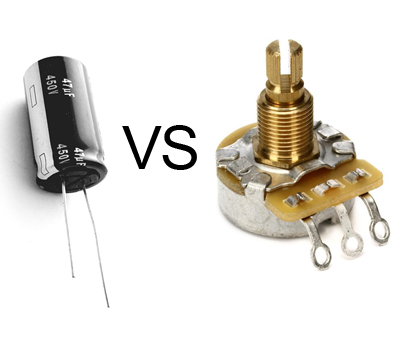
By Ed Malaker
Posted 07/13/2019
What Do Capacitors Do In Your Circuit?
Capacitors do many different things, but in your circuit, they do two main things.
First, they filter any direct current from your audio signal, which is alternating current. Separating the direct current is often necessary for the performance of the circuit, but it is also a safety precaution to keep direct current from moving between the guitar and the amplifier, possibly creating a life-threatening electrical hazard. To remove any stray direct current, capacitors are often found at the input jack, among other places.
The next thing that capacitors do is filter alternating current, based on the value of the capacitor. We use capacitors to build high and low pass filters and to tune our circuit to work in a specific frequency range. We also use them, along with a resistor and a potentiometer, to create a tone control. We can use multiple capacitors with multiple potentiometers to create a “multiband equalizer.”
What Do Potentiometers Do In Your Circuit?
Potentiometers are variable resistors that create a “fork in the road” for an electric signal. The best way to understand how a potentiometer works is to envision a left/right balance control on an audio stereo system. This particular potentiometer is the same as any other except that it has a divot built in, to let you know when you are precisely midway through the full throw of the pot.
A potentiometer will have three tabs on it: Tab 1, Tab 2, and Tab 3. On a balance pot, an audio signal comes in on Tab 2. Tab 1 will go to the Left Speaker and Tab 3 will go to the Right Speaker. When the pot is rotated toward Tab 1, the Left Speaker will play at full volume, because there will be no resistance between Tab 1 and Tab 2, but a resistance equal to the value of the potentiometer will be between Tab 2 and Tab 3, so the Right Speaker will produce no sound. Rotating the pot to Tab 3 will cause the opposite to happen, and the Right Speaker will play at full volume, while the Left Speaker shuts off.
If you stop at the divot in the middle of the potentiometer, the Left and Right speakers will both play at half volume, because they each get half resistance. Since each Speaker is playing at the same Volume, we call them balanced or “centered.” All potentiometers work by using resistance to create a “fork in the road.” If you are not splitting a signal between Left and Right speakers, then you might be deciding how much goes to the next stage of an amplifier, how much gets filtered by a capacitor, how much goes to Ground, etc.
If you’ve found this article helpful, please feel free to share this with your friends on Facebook and Twitter. For more articles on guitar electronics, visit humbuckersoup.com.
